Promoting and Celebrating Cultural Heritage in China
VerifiedAdded on 2022/11/29
|12
|2839
|137
AI Summary
This article discusses the significance of promoting and celebrating cultural heritage in China. It explores various methods such as cultural tourism, school lessons, museum visits, and internet resources to promote and preserve China's cultural past. The article also highlights the top historical struct...
Read More
Contribute Materials
Your contribution can guide someone’s learning journey. Share your
documents today.
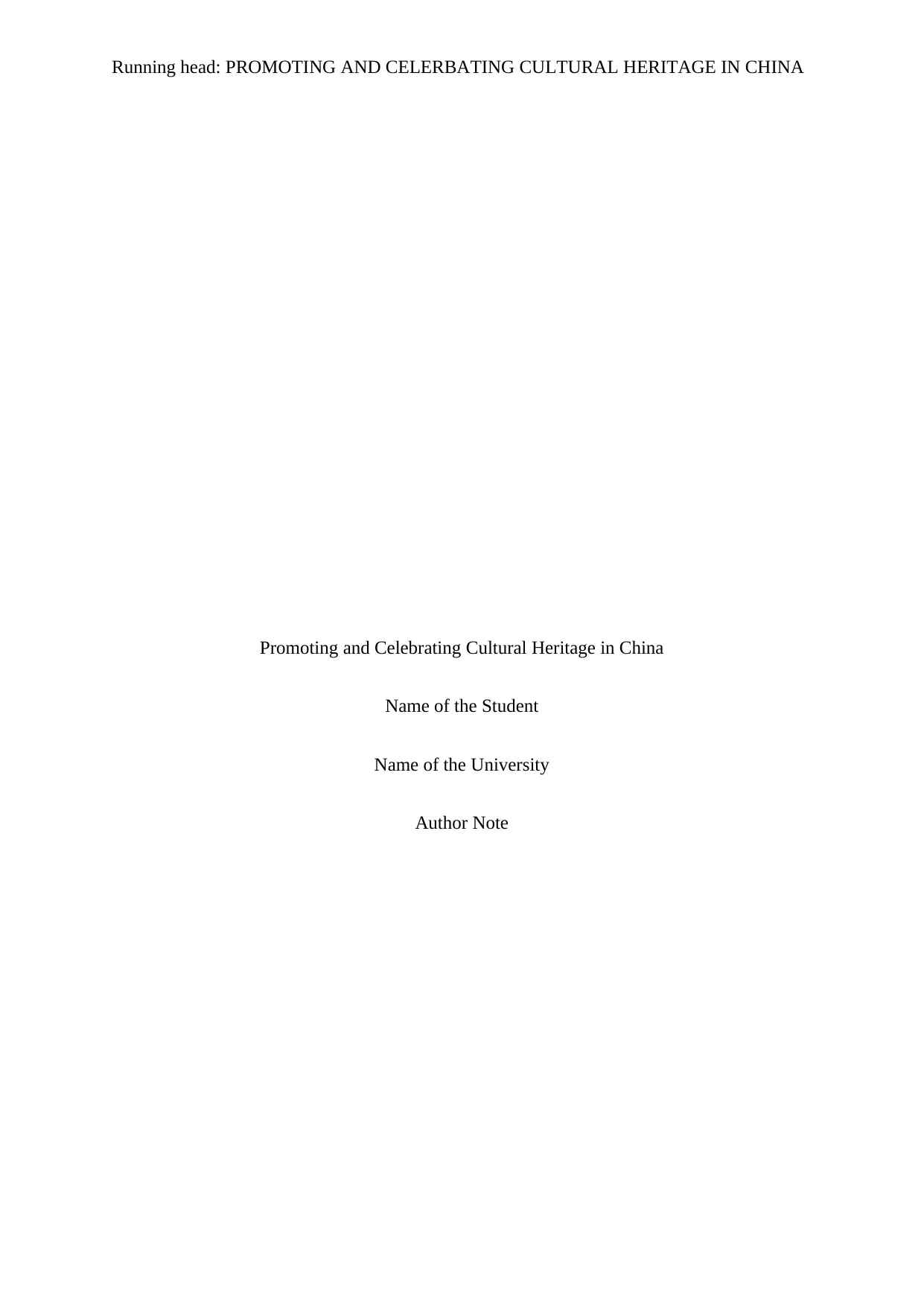
Running head: PROMOTING AND CELERBATING CULTURAL HERITAGE IN CHINA
Promoting and Celebrating Cultural Heritage in China
Name of the Student
Name of the University
Author Note
Promoting and Celebrating Cultural Heritage in China
Name of the Student
Name of the University
Author Note
Secure Best Marks with AI Grader
Need help grading? Try our AI Grader for instant feedback on your assignments.
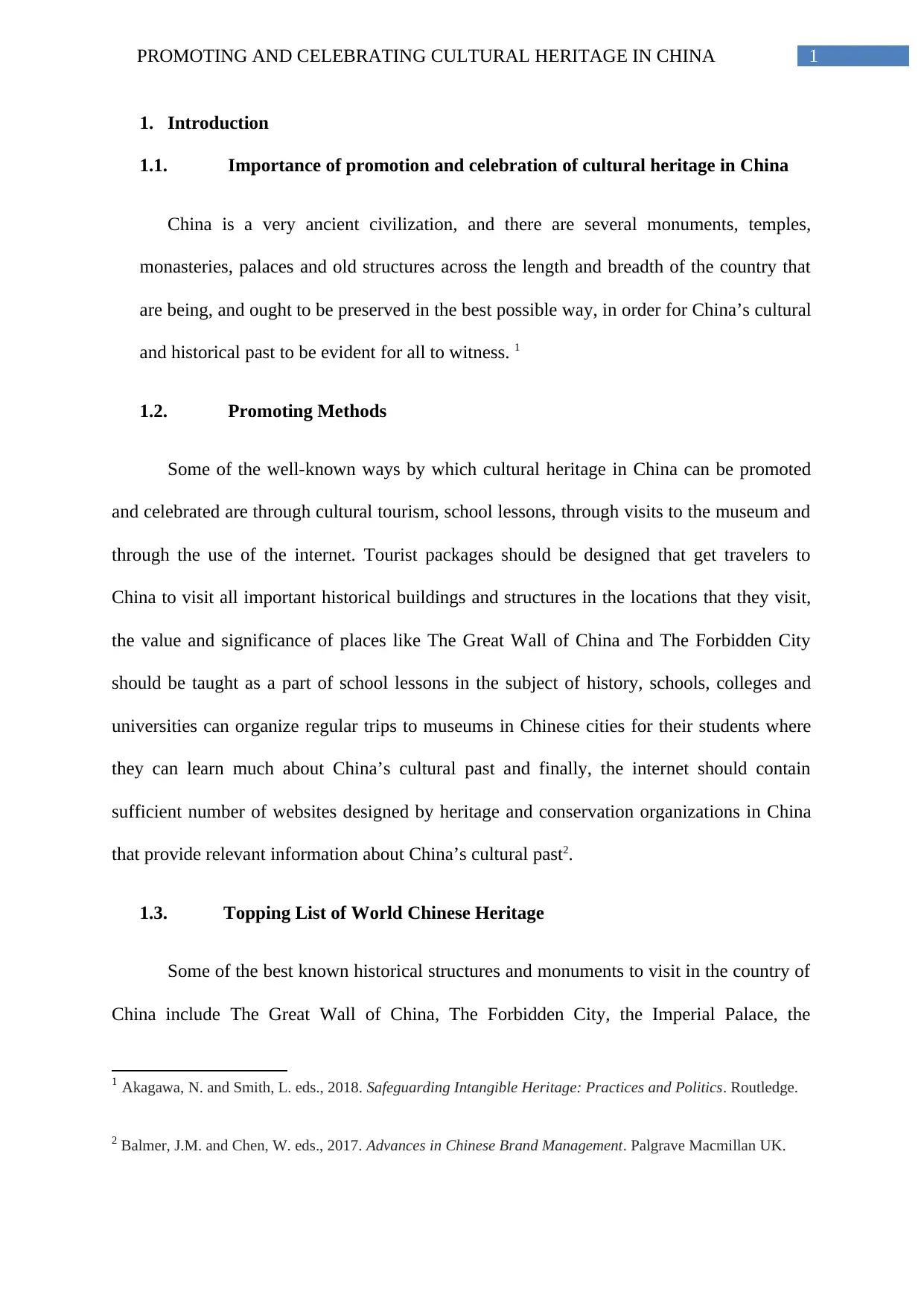
1PROMOTING AND CELEBRATING CULTURAL HERITAGE IN CHINA
1. Introduction
1.1. Importance of promotion and celebration of cultural heritage in China
China is a very ancient civilization, and there are several monuments, temples,
monasteries, palaces and old structures across the length and breadth of the country that
are being, and ought to be preserved in the best possible way, in order for China’s cultural
and historical past to be evident for all to witness. 1
1.2. Promoting Methods
Some of the well-known ways by which cultural heritage in China can be promoted
and celebrated are through cultural tourism, school lessons, through visits to the museum and
through the use of the internet. Tourist packages should be designed that get travelers to
China to visit all important historical buildings and structures in the locations that they visit,
the value and significance of places like The Great Wall of China and The Forbidden City
should be taught as a part of school lessons in the subject of history, schools, colleges and
universities can organize regular trips to museums in Chinese cities for their students where
they can learn much about China’s cultural past and finally, the internet should contain
sufficient number of websites designed by heritage and conservation organizations in China
that provide relevant information about China’s cultural past2.
1.3. Topping List of World Chinese Heritage
Some of the best known historical structures and monuments to visit in the country of
China include The Great Wall of China, The Forbidden City, the Imperial Palace, the
1 Akagawa, N. and Smith, L. eds., 2018. Safeguarding Intangible Heritage: Practices and Politics. Routledge.
2 Balmer, J.M. and Chen, W. eds., 2017. Advances in Chinese Brand Management. Palgrave Macmillan UK.
1. Introduction
1.1. Importance of promotion and celebration of cultural heritage in China
China is a very ancient civilization, and there are several monuments, temples,
monasteries, palaces and old structures across the length and breadth of the country that
are being, and ought to be preserved in the best possible way, in order for China’s cultural
and historical past to be evident for all to witness. 1
1.2. Promoting Methods
Some of the well-known ways by which cultural heritage in China can be promoted
and celebrated are through cultural tourism, school lessons, through visits to the museum and
through the use of the internet. Tourist packages should be designed that get travelers to
China to visit all important historical buildings and structures in the locations that they visit,
the value and significance of places like The Great Wall of China and The Forbidden City
should be taught as a part of school lessons in the subject of history, schools, colleges and
universities can organize regular trips to museums in Chinese cities for their students where
they can learn much about China’s cultural past and finally, the internet should contain
sufficient number of websites designed by heritage and conservation organizations in China
that provide relevant information about China’s cultural past2.
1.3. Topping List of World Chinese Heritage
Some of the best known historical structures and monuments to visit in the country of
China include The Great Wall of China, The Forbidden City, the Imperial Palace, the
1 Akagawa, N. and Smith, L. eds., 2018. Safeguarding Intangible Heritage: Practices and Politics. Routledge.
2 Balmer, J.M. and Chen, W. eds., 2017. Advances in Chinese Brand Management. Palgrave Macmillan UK.
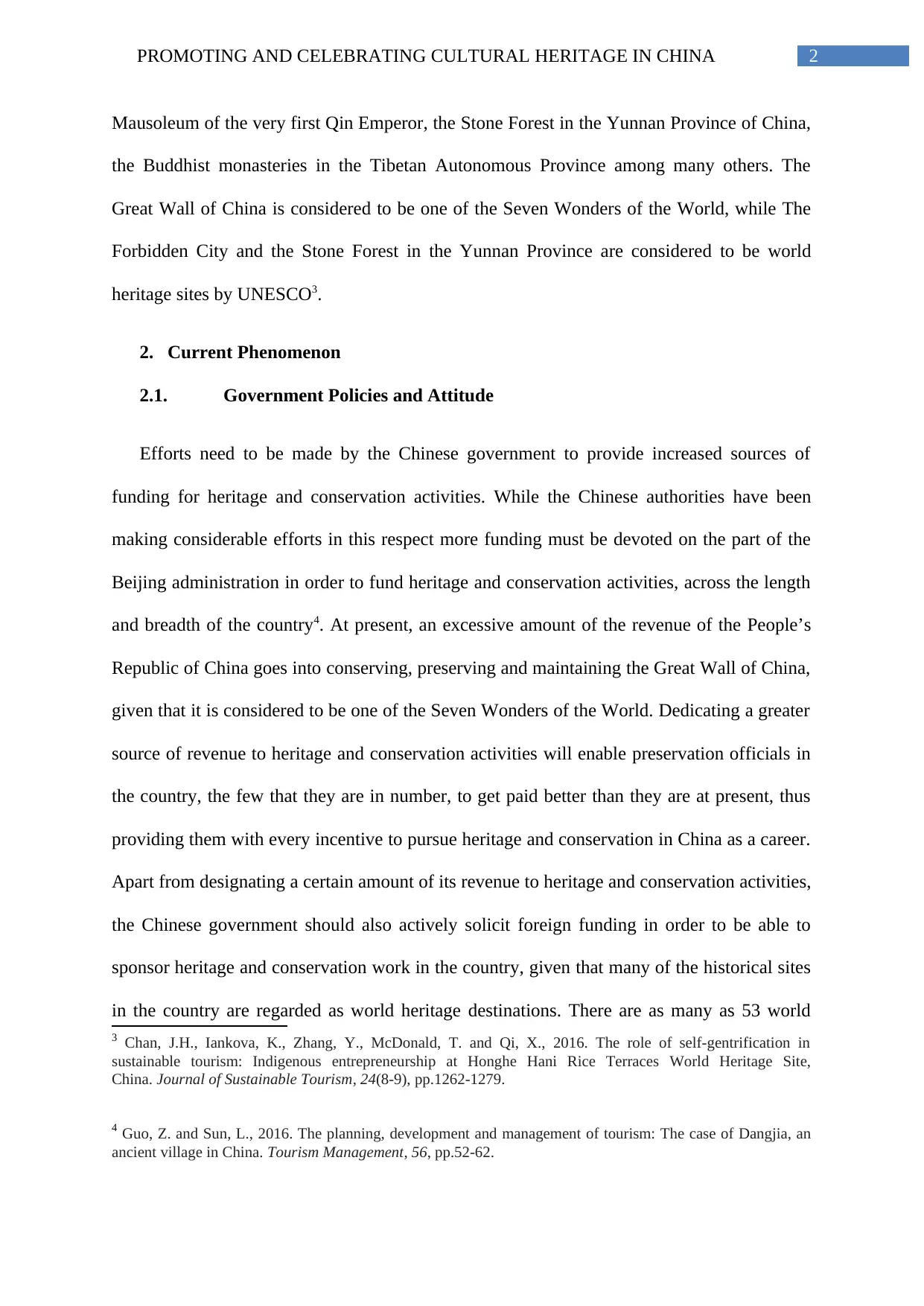
2PROMOTING AND CELEBRATING CULTURAL HERITAGE IN CHINA
Mausoleum of the very first Qin Emperor, the Stone Forest in the Yunnan Province of China,
the Buddhist monasteries in the Tibetan Autonomous Province among many others. The
Great Wall of China is considered to be one of the Seven Wonders of the World, while The
Forbidden City and the Stone Forest in the Yunnan Province are considered to be world
heritage sites by UNESCO3.
2. Current Phenomenon
2.1. Government Policies and Attitude
Efforts need to be made by the Chinese government to provide increased sources of
funding for heritage and conservation activities. While the Chinese authorities have been
making considerable efforts in this respect more funding must be devoted on the part of the
Beijing administration in order to fund heritage and conservation activities, across the length
and breadth of the country4. At present, an excessive amount of the revenue of the People’s
Republic of China goes into conserving, preserving and maintaining the Great Wall of China,
given that it is considered to be one of the Seven Wonders of the World. Dedicating a greater
source of revenue to heritage and conservation activities will enable preservation officials in
the country, the few that they are in number, to get paid better than they are at present, thus
providing them with every incentive to pursue heritage and conservation in China as a career.
Apart from designating a certain amount of its revenue to heritage and conservation activities,
the Chinese government should also actively solicit foreign funding in order to be able to
sponsor heritage and conservation work in the country, given that many of the historical sites
in the country are regarded as world heritage destinations. There are as many as 53 world
3 Chan, J.H., Iankova, K., Zhang, Y., McDonald, T. and Qi, X., 2016. The role of self-gentrification in
sustainable tourism: Indigenous entrepreneurship at Honghe Hani Rice Terraces World Heritage Site,
China. Journal of Sustainable Tourism, 24(8-9), pp.1262-1279.
4 Guo, Z. and Sun, L., 2016. The planning, development and management of tourism: The case of Dangjia, an
ancient village in China. Tourism Management, 56, pp.52-62.
Mausoleum of the very first Qin Emperor, the Stone Forest in the Yunnan Province of China,
the Buddhist monasteries in the Tibetan Autonomous Province among many others. The
Great Wall of China is considered to be one of the Seven Wonders of the World, while The
Forbidden City and the Stone Forest in the Yunnan Province are considered to be world
heritage sites by UNESCO3.
2. Current Phenomenon
2.1. Government Policies and Attitude
Efforts need to be made by the Chinese government to provide increased sources of
funding for heritage and conservation activities. While the Chinese authorities have been
making considerable efforts in this respect more funding must be devoted on the part of the
Beijing administration in order to fund heritage and conservation activities, across the length
and breadth of the country4. At present, an excessive amount of the revenue of the People’s
Republic of China goes into conserving, preserving and maintaining the Great Wall of China,
given that it is considered to be one of the Seven Wonders of the World. Dedicating a greater
source of revenue to heritage and conservation activities will enable preservation officials in
the country, the few that they are in number, to get paid better than they are at present, thus
providing them with every incentive to pursue heritage and conservation in China as a career.
Apart from designating a certain amount of its revenue to heritage and conservation activities,
the Chinese government should also actively solicit foreign funding in order to be able to
sponsor heritage and conservation work in the country, given that many of the historical sites
in the country are regarded as world heritage destinations. There are as many as 53 world
3 Chan, J.H., Iankova, K., Zhang, Y., McDonald, T. and Qi, X., 2016. The role of self-gentrification in
sustainable tourism: Indigenous entrepreneurship at Honghe Hani Rice Terraces World Heritage Site,
China. Journal of Sustainable Tourism, 24(8-9), pp.1262-1279.
4 Guo, Z. and Sun, L., 2016. The planning, development and management of tourism: The case of Dangjia, an
ancient village in China. Tourism Management, 56, pp.52-62.
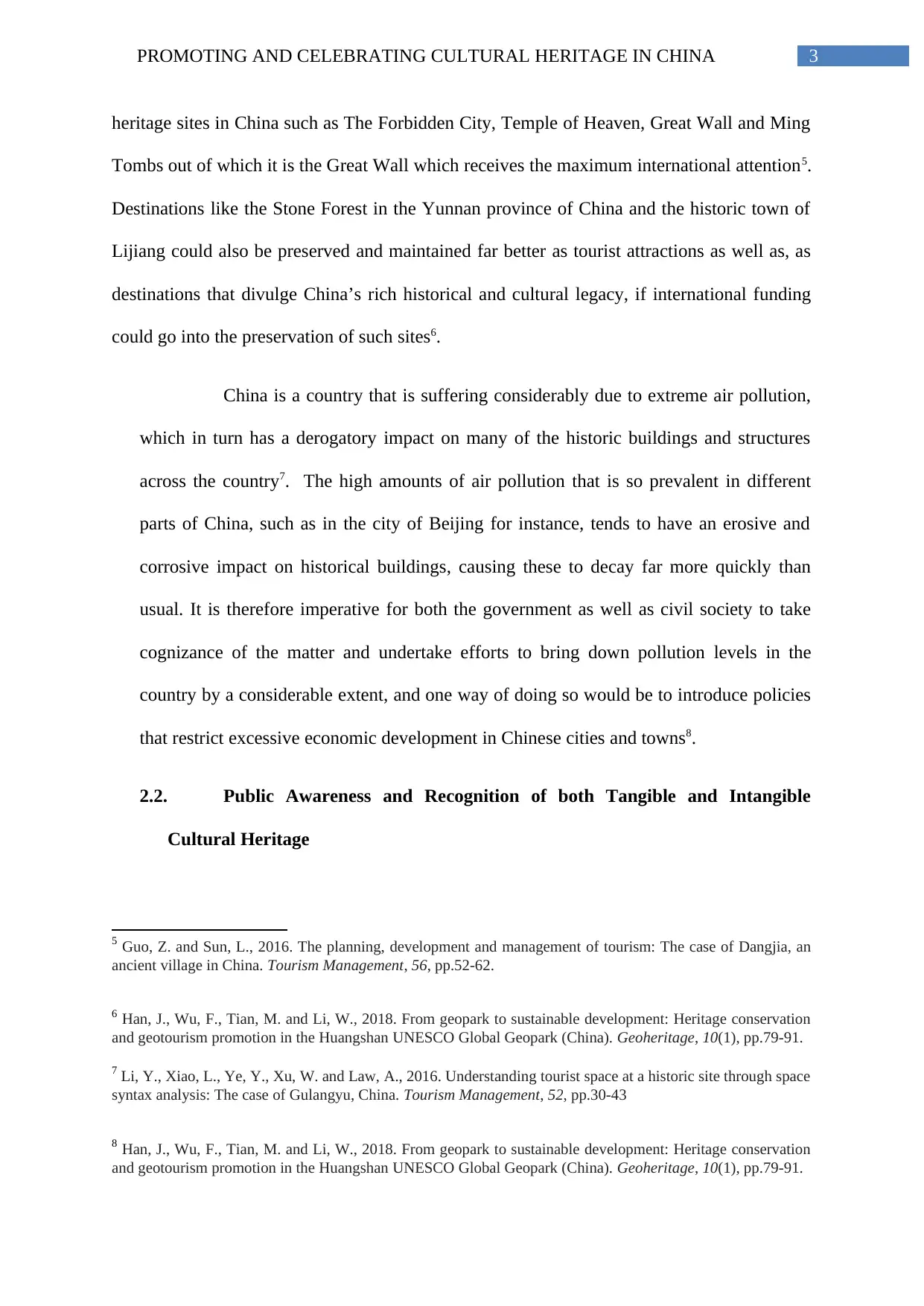
3PROMOTING AND CELEBRATING CULTURAL HERITAGE IN CHINA
heritage sites in China such as The Forbidden City, Temple of Heaven, Great Wall and Ming
Tombs out of which it is the Great Wall which receives the maximum international attention5.
Destinations like the Stone Forest in the Yunnan province of China and the historic town of
Lijiang could also be preserved and maintained far better as tourist attractions as well as, as
destinations that divulge China’s rich historical and cultural legacy, if international funding
could go into the preservation of such sites6.
China is a country that is suffering considerably due to extreme air pollution,
which in turn has a derogatory impact on many of the historic buildings and structures
across the country7. The high amounts of air pollution that is so prevalent in different
parts of China, such as in the city of Beijing for instance, tends to have an erosive and
corrosive impact on historical buildings, causing these to decay far more quickly than
usual. It is therefore imperative for both the government as well as civil society to take
cognizance of the matter and undertake efforts to bring down pollution levels in the
country by a considerable extent, and one way of doing so would be to introduce policies
that restrict excessive economic development in Chinese cities and towns8.
2.2. Public Awareness and Recognition of both Tangible and Intangible
Cultural Heritage
5 Guo, Z. and Sun, L., 2016. The planning, development and management of tourism: The case of Dangjia, an
ancient village in China. Tourism Management, 56, pp.52-62.
6 Han, J., Wu, F., Tian, M. and Li, W., 2018. From geopark to sustainable development: Heritage conservation
and geotourism promotion in the Huangshan UNESCO Global Geopark (China). Geoheritage, 10(1), pp.79-91.
7 Li, Y., Xiao, L., Ye, Y., Xu, W. and Law, A., 2016. Understanding tourist space at a historic site through space
syntax analysis: The case of Gulangyu, China. Tourism Management, 52, pp.30-43
8 Han, J., Wu, F., Tian, M. and Li, W., 2018. From geopark to sustainable development: Heritage conservation
and geotourism promotion in the Huangshan UNESCO Global Geopark (China). Geoheritage, 10(1), pp.79-91.
heritage sites in China such as The Forbidden City, Temple of Heaven, Great Wall and Ming
Tombs out of which it is the Great Wall which receives the maximum international attention5.
Destinations like the Stone Forest in the Yunnan province of China and the historic town of
Lijiang could also be preserved and maintained far better as tourist attractions as well as, as
destinations that divulge China’s rich historical and cultural legacy, if international funding
could go into the preservation of such sites6.
China is a country that is suffering considerably due to extreme air pollution,
which in turn has a derogatory impact on many of the historic buildings and structures
across the country7. The high amounts of air pollution that is so prevalent in different
parts of China, such as in the city of Beijing for instance, tends to have an erosive and
corrosive impact on historical buildings, causing these to decay far more quickly than
usual. It is therefore imperative for both the government as well as civil society to take
cognizance of the matter and undertake efforts to bring down pollution levels in the
country by a considerable extent, and one way of doing so would be to introduce policies
that restrict excessive economic development in Chinese cities and towns8.
2.2. Public Awareness and Recognition of both Tangible and Intangible
Cultural Heritage
5 Guo, Z. and Sun, L., 2016. The planning, development and management of tourism: The case of Dangjia, an
ancient village in China. Tourism Management, 56, pp.52-62.
6 Han, J., Wu, F., Tian, M. and Li, W., 2018. From geopark to sustainable development: Heritage conservation
and geotourism promotion in the Huangshan UNESCO Global Geopark (China). Geoheritage, 10(1), pp.79-91.
7 Li, Y., Xiao, L., Ye, Y., Xu, W. and Law, A., 2016. Understanding tourist space at a historic site through space
syntax analysis: The case of Gulangyu, China. Tourism Management, 52, pp.30-43
8 Han, J., Wu, F., Tian, M. and Li, W., 2018. From geopark to sustainable development: Heritage conservation
and geotourism promotion in the Huangshan UNESCO Global Geopark (China). Geoheritage, 10(1), pp.79-91.
Secure Best Marks with AI Grader
Need help grading? Try our AI Grader for instant feedback on your assignments.
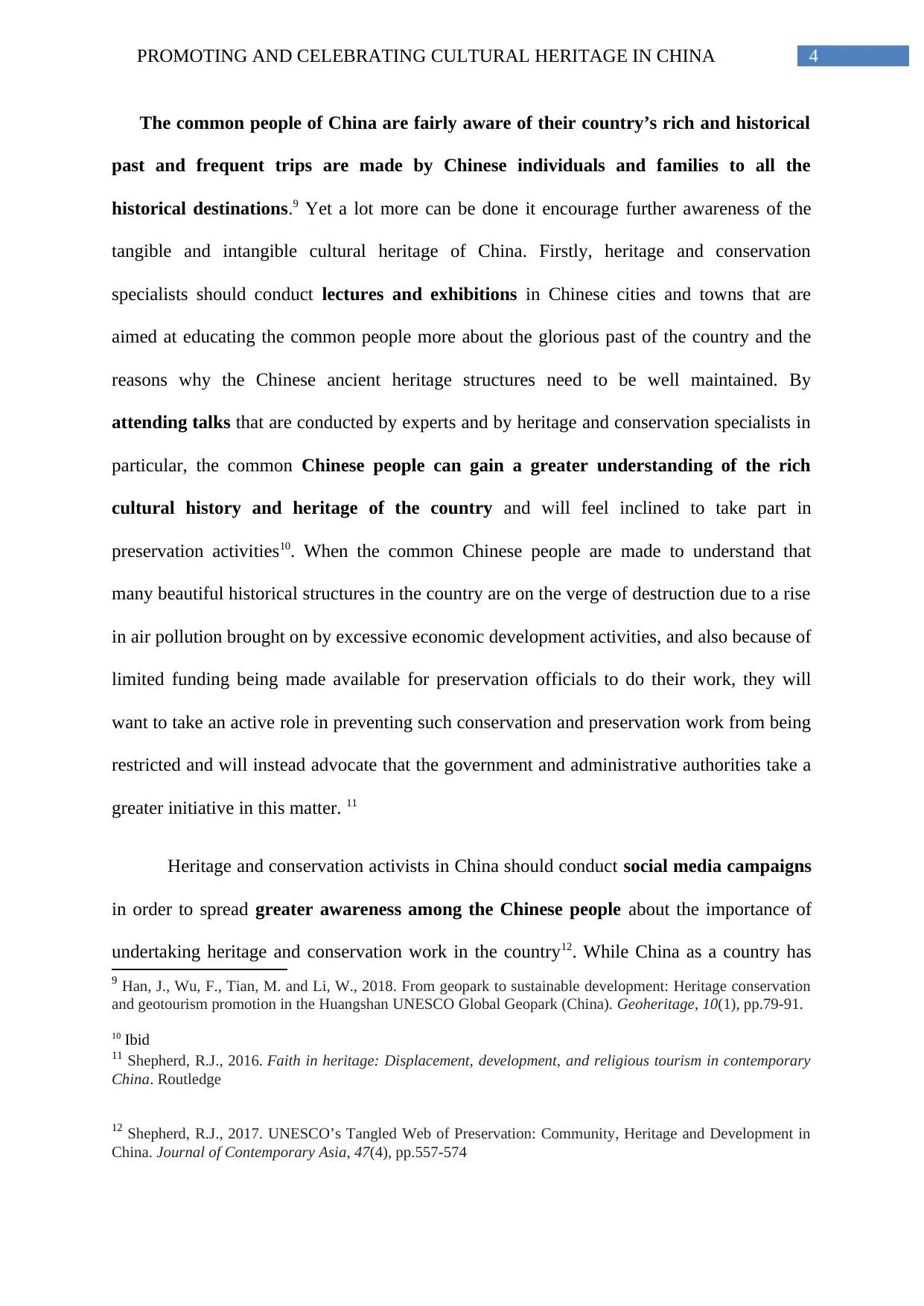
4PROMOTING AND CELEBRATING CULTURAL HERITAGE IN CHINA
The common people of China are fairly aware of their country’s rich and historical
past and frequent trips are made by Chinese individuals and families to all the
historical destinations.9 Yet a lot more can be done it encourage further awareness of the
tangible and intangible cultural heritage of China. Firstly, heritage and conservation
specialists should conduct lectures and exhibitions in Chinese cities and towns that are
aimed at educating the common people more about the glorious past of the country and the
reasons why the Chinese ancient heritage structures need to be well maintained. By
attending talks that are conducted by experts and by heritage and conservation specialists in
particular, the common Chinese people can gain a greater understanding of the rich
cultural history and heritage of the country and will feel inclined to take part in
preservation activities10. When the common Chinese people are made to understand that
many beautiful historical structures in the country are on the verge of destruction due to a rise
in air pollution brought on by excessive economic development activities, and also because of
limited funding being made available for preservation officials to do their work, they will
want to take an active role in preventing such conservation and preservation work from being
restricted and will instead advocate that the government and administrative authorities take a
greater initiative in this matter. 11
Heritage and conservation activists in China should conduct social media campaigns
in order to spread greater awareness among the Chinese people about the importance of
undertaking heritage and conservation work in the country12. While China as a country has
9 Han, J., Wu, F., Tian, M. and Li, W., 2018. From geopark to sustainable development: Heritage conservation
and geotourism promotion in the Huangshan UNESCO Global Geopark (China). Geoheritage, 10(1), pp.79-91.
10 Ibid
11 Shepherd, R.J., 2016. Faith in heritage: Displacement, development, and religious tourism in contemporary
China. Routledge
12 Shepherd, R.J., 2017. UNESCO’s Tangled Web of Preservation: Community, Heritage and Development in
China. Journal of Contemporary Asia, 47(4), pp.557-574
The common people of China are fairly aware of their country’s rich and historical
past and frequent trips are made by Chinese individuals and families to all the
historical destinations.9 Yet a lot more can be done it encourage further awareness of the
tangible and intangible cultural heritage of China. Firstly, heritage and conservation
specialists should conduct lectures and exhibitions in Chinese cities and towns that are
aimed at educating the common people more about the glorious past of the country and the
reasons why the Chinese ancient heritage structures need to be well maintained. By
attending talks that are conducted by experts and by heritage and conservation specialists in
particular, the common Chinese people can gain a greater understanding of the rich
cultural history and heritage of the country and will feel inclined to take part in
preservation activities10. When the common Chinese people are made to understand that
many beautiful historical structures in the country are on the verge of destruction due to a rise
in air pollution brought on by excessive economic development activities, and also because of
limited funding being made available for preservation officials to do their work, they will
want to take an active role in preventing such conservation and preservation work from being
restricted and will instead advocate that the government and administrative authorities take a
greater initiative in this matter. 11
Heritage and conservation activists in China should conduct social media campaigns
in order to spread greater awareness among the Chinese people about the importance of
undertaking heritage and conservation work in the country12. While China as a country has
9 Han, J., Wu, F., Tian, M. and Li, W., 2018. From geopark to sustainable development: Heritage conservation
and geotourism promotion in the Huangshan UNESCO Global Geopark (China). Geoheritage, 10(1), pp.79-91.
10 Ibid
11 Shepherd, R.J., 2016. Faith in heritage: Displacement, development, and religious tourism in contemporary
China. Routledge
12 Shepherd, R.J., 2017. UNESCO’s Tangled Web of Preservation: Community, Heritage and Development in
China. Journal of Contemporary Asia, 47(4), pp.557-574
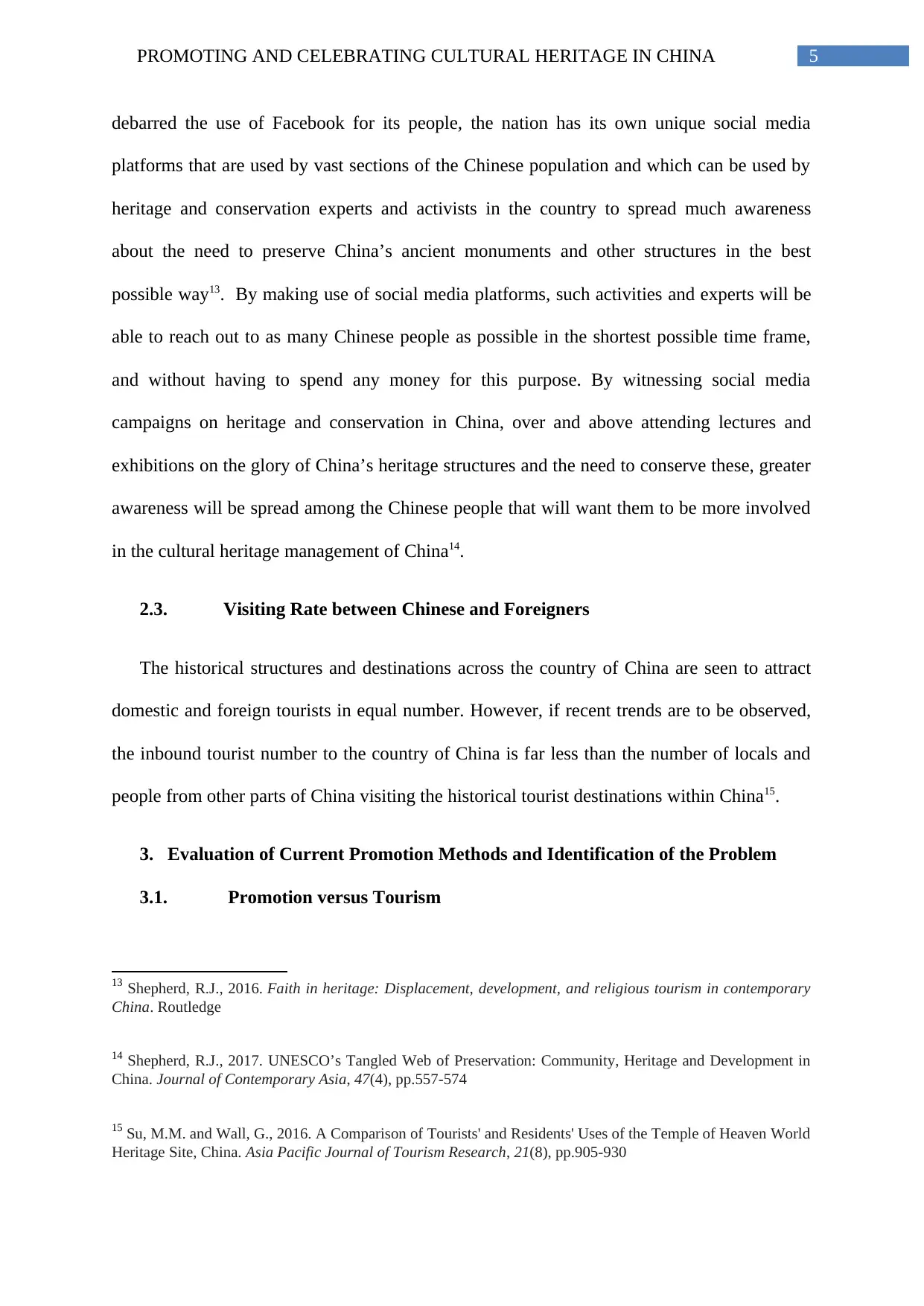
5PROMOTING AND CELEBRATING CULTURAL HERITAGE IN CHINA
debarred the use of Facebook for its people, the nation has its own unique social media
platforms that are used by vast sections of the Chinese population and which can be used by
heritage and conservation experts and activists in the country to spread much awareness
about the need to preserve China’s ancient monuments and other structures in the best
possible way13. By making use of social media platforms, such activities and experts will be
able to reach out to as many Chinese people as possible in the shortest possible time frame,
and without having to spend any money for this purpose. By witnessing social media
campaigns on heritage and conservation in China, over and above attending lectures and
exhibitions on the glory of China’s heritage structures and the need to conserve these, greater
awareness will be spread among the Chinese people that will want them to be more involved
in the cultural heritage management of China14.
2.3. Visiting Rate between Chinese and Foreigners
The historical structures and destinations across the country of China are seen to attract
domestic and foreign tourists in equal number. However, if recent trends are to be observed,
the inbound tourist number to the country of China is far less than the number of locals and
people from other parts of China visiting the historical tourist destinations within China15.
3. Evaluation of Current Promotion Methods and Identification of the Problem
3.1. Promotion versus Tourism
13 Shepherd, R.J., 2016. Faith in heritage: Displacement, development, and religious tourism in contemporary
China. Routledge
14 Shepherd, R.J., 2017. UNESCO’s Tangled Web of Preservation: Community, Heritage and Development in
China. Journal of Contemporary Asia, 47(4), pp.557-574
15 Su, M.M. and Wall, G., 2016. A Comparison of Tourists' and Residents' Uses of the Temple of Heaven World
Heritage Site, China. Asia Pacific Journal of Tourism Research, 21(8), pp.905-930
debarred the use of Facebook for its people, the nation has its own unique social media
platforms that are used by vast sections of the Chinese population and which can be used by
heritage and conservation experts and activists in the country to spread much awareness
about the need to preserve China’s ancient monuments and other structures in the best
possible way13. By making use of social media platforms, such activities and experts will be
able to reach out to as many Chinese people as possible in the shortest possible time frame,
and without having to spend any money for this purpose. By witnessing social media
campaigns on heritage and conservation in China, over and above attending lectures and
exhibitions on the glory of China’s heritage structures and the need to conserve these, greater
awareness will be spread among the Chinese people that will want them to be more involved
in the cultural heritage management of China14.
2.3. Visiting Rate between Chinese and Foreigners
The historical structures and destinations across the country of China are seen to attract
domestic and foreign tourists in equal number. However, if recent trends are to be observed,
the inbound tourist number to the country of China is far less than the number of locals and
people from other parts of China visiting the historical tourist destinations within China15.
3. Evaluation of Current Promotion Methods and Identification of the Problem
3.1. Promotion versus Tourism
13 Shepherd, R.J., 2016. Faith in heritage: Displacement, development, and religious tourism in contemporary
China. Routledge
14 Shepherd, R.J., 2017. UNESCO’s Tangled Web of Preservation: Community, Heritage and Development in
China. Journal of Contemporary Asia, 47(4), pp.557-574
15 Su, M.M. and Wall, G., 2016. A Comparison of Tourists' and Residents' Uses of the Temple of Heaven World
Heritage Site, China. Asia Pacific Journal of Tourism Research, 21(8), pp.905-930
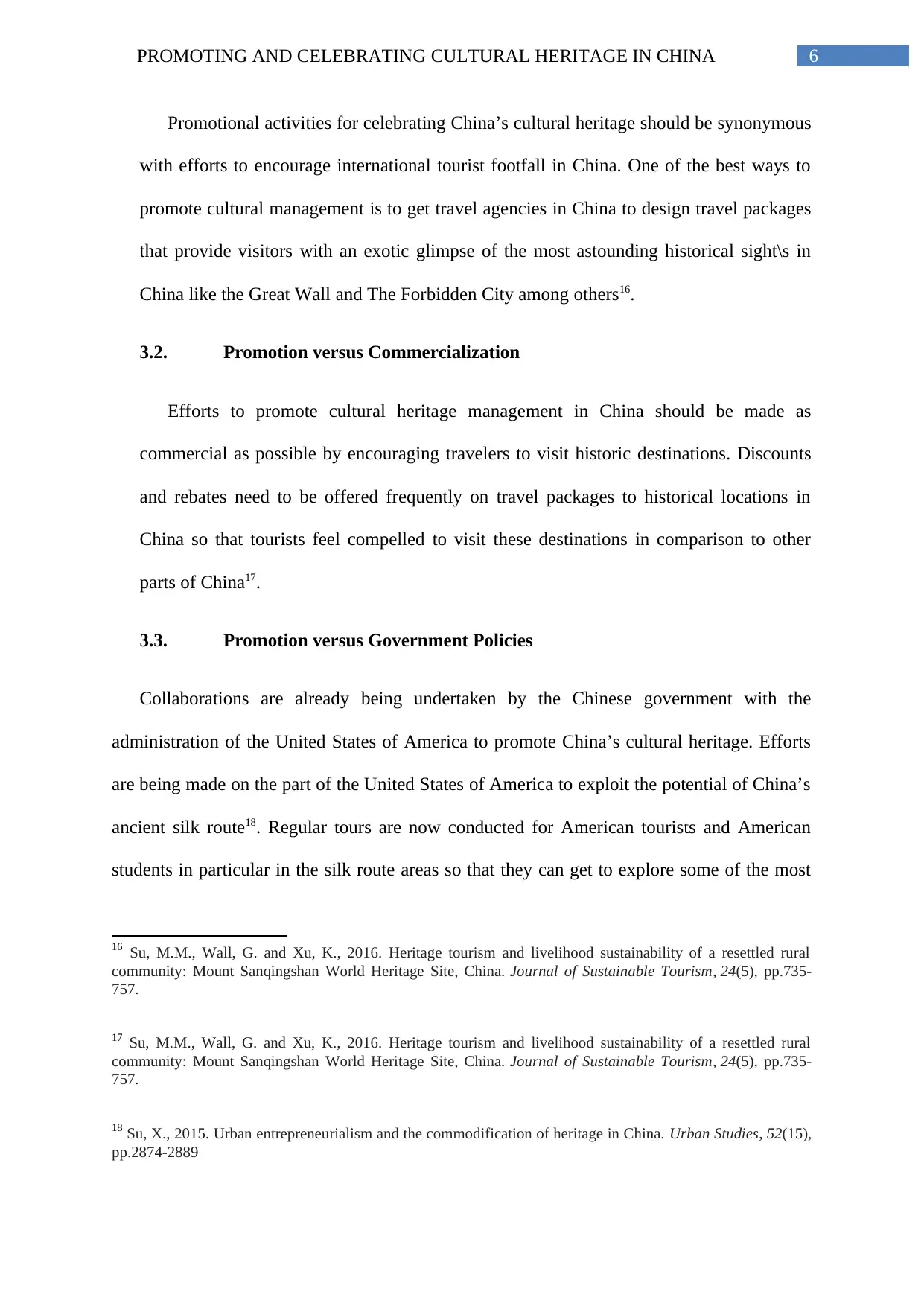
6PROMOTING AND CELEBRATING CULTURAL HERITAGE IN CHINA
Promotional activities for celebrating China’s cultural heritage should be synonymous
with efforts to encourage international tourist footfall in China. One of the best ways to
promote cultural management is to get travel agencies in China to design travel packages
that provide visitors with an exotic glimpse of the most astounding historical sight\s in
China like the Great Wall and The Forbidden City among others16.
3.2. Promotion versus Commercialization
Efforts to promote cultural heritage management in China should be made as
commercial as possible by encouraging travelers to visit historic destinations. Discounts
and rebates need to be offered frequently on travel packages to historical locations in
China so that tourists feel compelled to visit these destinations in comparison to other
parts of China17.
3.3. Promotion versus Government Policies
Collaborations are already being undertaken by the Chinese government with the
administration of the United States of America to promote China’s cultural heritage. Efforts
are being made on the part of the United States of America to exploit the potential of China’s
ancient silk route18. Regular tours are now conducted for American tourists and American
students in particular in the silk route areas so that they can get to explore some of the most
16 Su, M.M., Wall, G. and Xu, K., 2016. Heritage tourism and livelihood sustainability of a resettled rural
community: Mount Sanqingshan World Heritage Site, China. Journal of Sustainable Tourism, 24(5), pp.735-
757.
17 Su, M.M., Wall, G. and Xu, K., 2016. Heritage tourism and livelihood sustainability of a resettled rural
community: Mount Sanqingshan World Heritage Site, China. Journal of Sustainable Tourism, 24(5), pp.735-
757.
18 Su, X., 2015. Urban entrepreneurialism and the commodification of heritage in China. Urban Studies, 52(15),
pp.2874-2889
Promotional activities for celebrating China’s cultural heritage should be synonymous
with efforts to encourage international tourist footfall in China. One of the best ways to
promote cultural management is to get travel agencies in China to design travel packages
that provide visitors with an exotic glimpse of the most astounding historical sight\s in
China like the Great Wall and The Forbidden City among others16.
3.2. Promotion versus Commercialization
Efforts to promote cultural heritage management in China should be made as
commercial as possible by encouraging travelers to visit historic destinations. Discounts
and rebates need to be offered frequently on travel packages to historical locations in
China so that tourists feel compelled to visit these destinations in comparison to other
parts of China17.
3.3. Promotion versus Government Policies
Collaborations are already being undertaken by the Chinese government with the
administration of the United States of America to promote China’s cultural heritage. Efforts
are being made on the part of the United States of America to exploit the potential of China’s
ancient silk route18. Regular tours are now conducted for American tourists and American
students in particular in the silk route areas so that they can get to explore some of the most
16 Su, M.M., Wall, G. and Xu, K., 2016. Heritage tourism and livelihood sustainability of a resettled rural
community: Mount Sanqingshan World Heritage Site, China. Journal of Sustainable Tourism, 24(5), pp.735-
757.
17 Su, M.M., Wall, G. and Xu, K., 2016. Heritage tourism and livelihood sustainability of a resettled rural
community: Mount Sanqingshan World Heritage Site, China. Journal of Sustainable Tourism, 24(5), pp.735-
757.
18 Su, X., 2015. Urban entrepreneurialism and the commodification of heritage in China. Urban Studies, 52(15),
pp.2874-2889
Paraphrase This Document
Need a fresh take? Get an instant paraphrase of this document with our AI Paraphraser
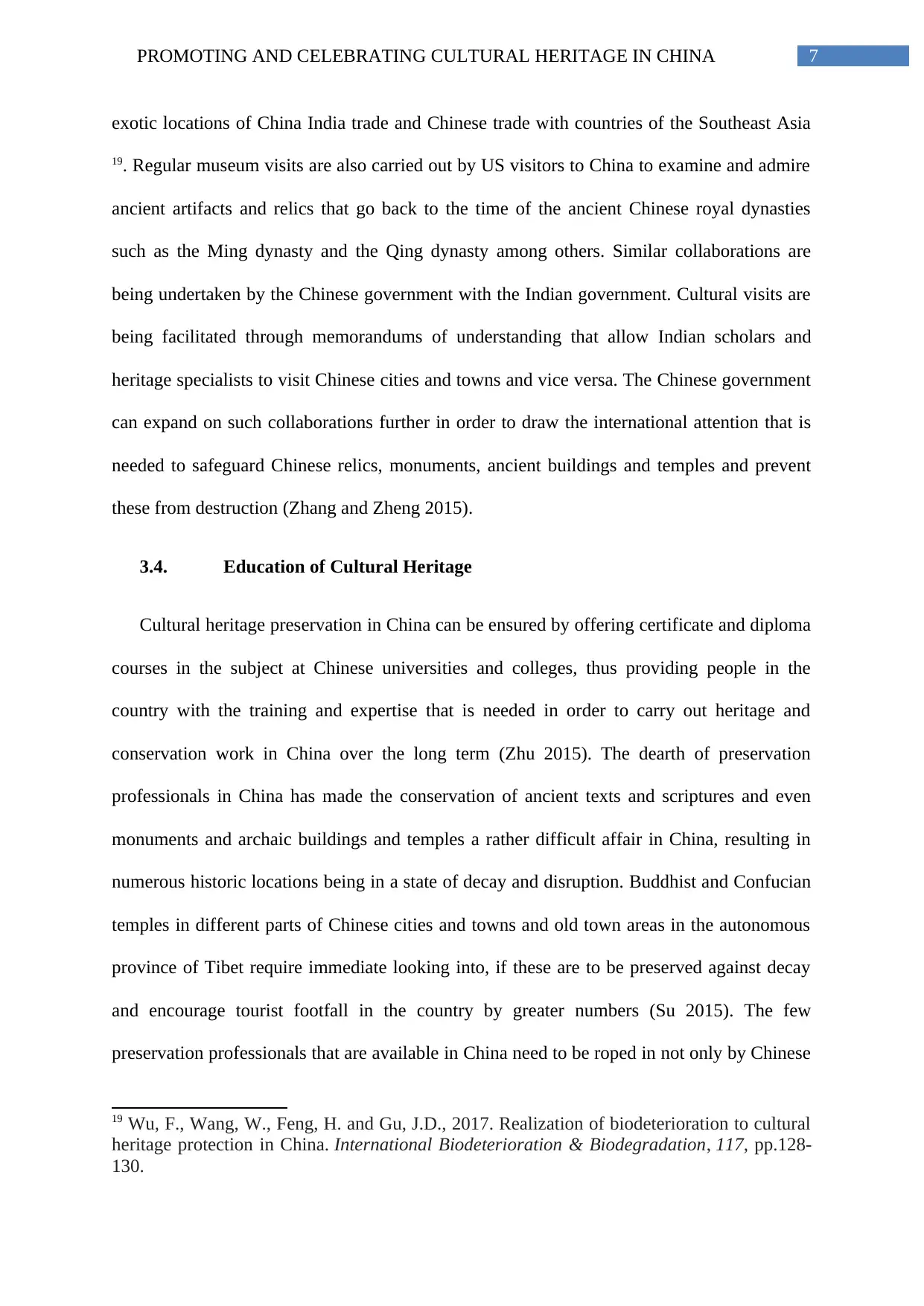
7PROMOTING AND CELEBRATING CULTURAL HERITAGE IN CHINA
exotic locations of China India trade and Chinese trade with countries of the Southeast Asia
19. Regular museum visits are also carried out by US visitors to China to examine and admire
ancient artifacts and relics that go back to the time of the ancient Chinese royal dynasties
such as the Ming dynasty and the Qing dynasty among others. Similar collaborations are
being undertaken by the Chinese government with the Indian government. Cultural visits are
being facilitated through memorandums of understanding that allow Indian scholars and
heritage specialists to visit Chinese cities and towns and vice versa. The Chinese government
can expand on such collaborations further in order to draw the international attention that is
needed to safeguard Chinese relics, monuments, ancient buildings and temples and prevent
these from destruction (Zhang and Zheng 2015).
3.4. Education of Cultural Heritage
Cultural heritage preservation in China can be ensured by offering certificate and diploma
courses in the subject at Chinese universities and colleges, thus providing people in the
country with the training and expertise that is needed in order to carry out heritage and
conservation work in China over the long term (Zhu 2015). The dearth of preservation
professionals in China has made the conservation of ancient texts and scriptures and even
monuments and archaic buildings and temples a rather difficult affair in China, resulting in
numerous historic locations being in a state of decay and disruption. Buddhist and Confucian
temples in different parts of Chinese cities and towns and old town areas in the autonomous
province of Tibet require immediate looking into, if these are to be preserved against decay
and encourage tourist footfall in the country by greater numbers (Su 2015). The few
preservation professionals that are available in China need to be roped in not only by Chinese
19 Wu, F., Wang, W., Feng, H. and Gu, J.D., 2017. Realization of biodeterioration to cultural
heritage protection in China. International Biodeterioration & Biodegradation, 117, pp.128-
130.
exotic locations of China India trade and Chinese trade with countries of the Southeast Asia
19. Regular museum visits are also carried out by US visitors to China to examine and admire
ancient artifacts and relics that go back to the time of the ancient Chinese royal dynasties
such as the Ming dynasty and the Qing dynasty among others. Similar collaborations are
being undertaken by the Chinese government with the Indian government. Cultural visits are
being facilitated through memorandums of understanding that allow Indian scholars and
heritage specialists to visit Chinese cities and towns and vice versa. The Chinese government
can expand on such collaborations further in order to draw the international attention that is
needed to safeguard Chinese relics, monuments, ancient buildings and temples and prevent
these from destruction (Zhang and Zheng 2015).
3.4. Education of Cultural Heritage
Cultural heritage preservation in China can be ensured by offering certificate and diploma
courses in the subject at Chinese universities and colleges, thus providing people in the
country with the training and expertise that is needed in order to carry out heritage and
conservation work in China over the long term (Zhu 2015). The dearth of preservation
professionals in China has made the conservation of ancient texts and scriptures and even
monuments and archaic buildings and temples a rather difficult affair in China, resulting in
numerous historic locations being in a state of decay and disruption. Buddhist and Confucian
temples in different parts of Chinese cities and towns and old town areas in the autonomous
province of Tibet require immediate looking into, if these are to be preserved against decay
and encourage tourist footfall in the country by greater numbers (Su 2015). The few
preservation professionals that are available in China need to be roped in not only by Chinese
19 Wu, F., Wang, W., Feng, H. and Gu, J.D., 2017. Realization of biodeterioration to cultural
heritage protection in China. International Biodeterioration & Biodegradation, 117, pp.128-
130.
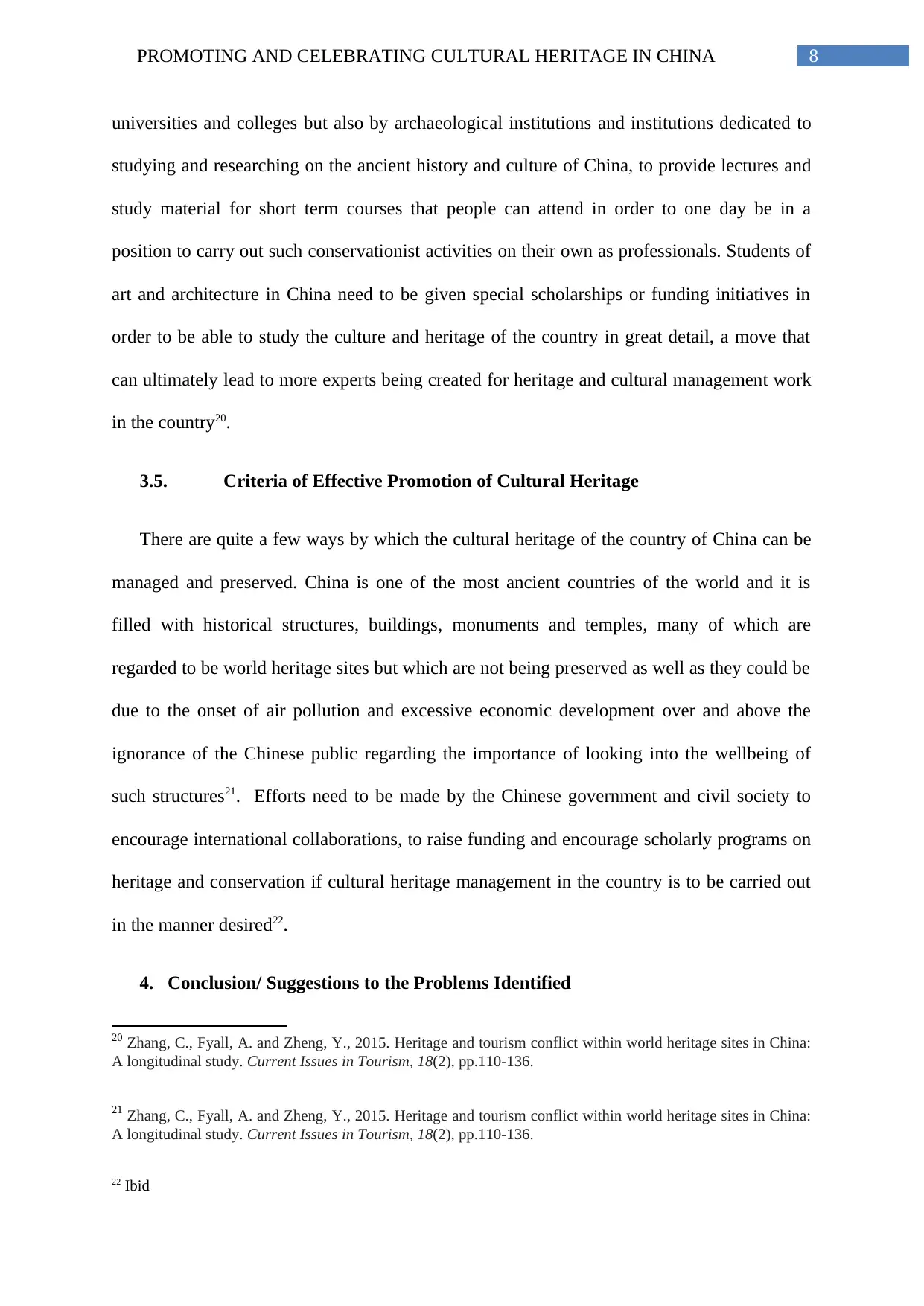
8PROMOTING AND CELEBRATING CULTURAL HERITAGE IN CHINA
universities and colleges but also by archaeological institutions and institutions dedicated to
studying and researching on the ancient history and culture of China, to provide lectures and
study material for short term courses that people can attend in order to one day be in a
position to carry out such conservationist activities on their own as professionals. Students of
art and architecture in China need to be given special scholarships or funding initiatives in
order to be able to study the culture and heritage of the country in great detail, a move that
can ultimately lead to more experts being created for heritage and cultural management work
in the country20.
3.5. Criteria of Effective Promotion of Cultural Heritage
There are quite a few ways by which the cultural heritage of the country of China can be
managed and preserved. China is one of the most ancient countries of the world and it is
filled with historical structures, buildings, monuments and temples, many of which are
regarded to be world heritage sites but which are not being preserved as well as they could be
due to the onset of air pollution and excessive economic development over and above the
ignorance of the Chinese public regarding the importance of looking into the wellbeing of
such structures21. Efforts need to be made by the Chinese government and civil society to
encourage international collaborations, to raise funding and encourage scholarly programs on
heritage and conservation if cultural heritage management in the country is to be carried out
in the manner desired22.
4. Conclusion/ Suggestions to the Problems Identified
20 Zhang, C., Fyall, A. and Zheng, Y., 2015. Heritage and tourism conflict within world heritage sites in China:
A longitudinal study. Current Issues in Tourism, 18(2), pp.110-136.
21 Zhang, C., Fyall, A. and Zheng, Y., 2015. Heritage and tourism conflict within world heritage sites in China:
A longitudinal study. Current Issues in Tourism, 18(2), pp.110-136.
22 Ibid
universities and colleges but also by archaeological institutions and institutions dedicated to
studying and researching on the ancient history and culture of China, to provide lectures and
study material for short term courses that people can attend in order to one day be in a
position to carry out such conservationist activities on their own as professionals. Students of
art and architecture in China need to be given special scholarships or funding initiatives in
order to be able to study the culture and heritage of the country in great detail, a move that
can ultimately lead to more experts being created for heritage and cultural management work
in the country20.
3.5. Criteria of Effective Promotion of Cultural Heritage
There are quite a few ways by which the cultural heritage of the country of China can be
managed and preserved. China is one of the most ancient countries of the world and it is
filled with historical structures, buildings, monuments and temples, many of which are
regarded to be world heritage sites but which are not being preserved as well as they could be
due to the onset of air pollution and excessive economic development over and above the
ignorance of the Chinese public regarding the importance of looking into the wellbeing of
such structures21. Efforts need to be made by the Chinese government and civil society to
encourage international collaborations, to raise funding and encourage scholarly programs on
heritage and conservation if cultural heritage management in the country is to be carried out
in the manner desired22.
4. Conclusion/ Suggestions to the Problems Identified
20 Zhang, C., Fyall, A. and Zheng, Y., 2015. Heritage and tourism conflict within world heritage sites in China:
A longitudinal study. Current Issues in Tourism, 18(2), pp.110-136.
21 Zhang, C., Fyall, A. and Zheng, Y., 2015. Heritage and tourism conflict within world heritage sites in China:
A longitudinal study. Current Issues in Tourism, 18(2), pp.110-136.
22 Ibid
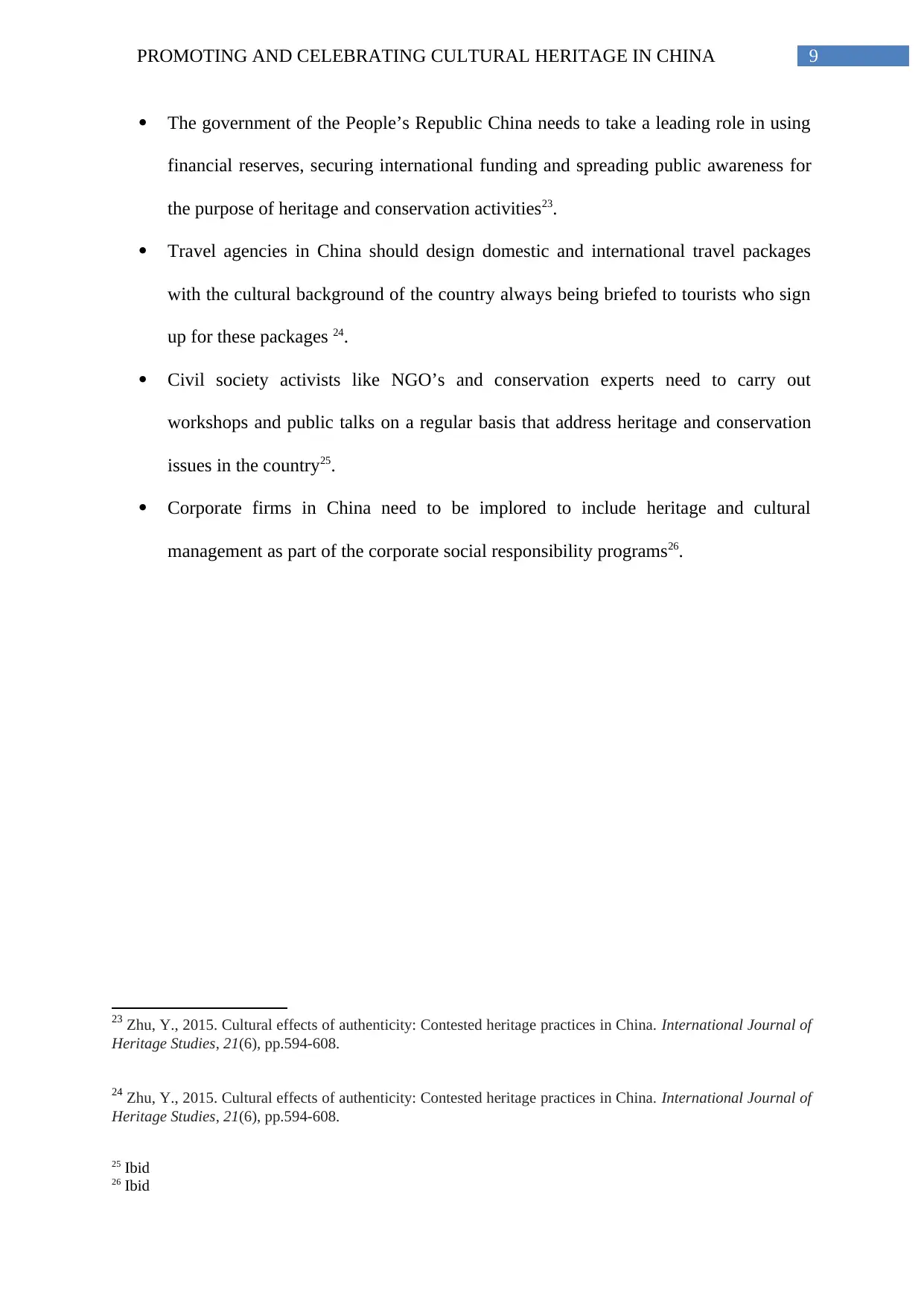
9PROMOTING AND CELEBRATING CULTURAL HERITAGE IN CHINA
The government of the People’s Republic China needs to take a leading role in using
financial reserves, securing international funding and spreading public awareness for
the purpose of heritage and conservation activities23.
Travel agencies in China should design domestic and international travel packages
with the cultural background of the country always being briefed to tourists who sign
up for these packages 24.
Civil society activists like NGO’s and conservation experts need to carry out
workshops and public talks on a regular basis that address heritage and conservation
issues in the country25.
Corporate firms in China need to be implored to include heritage and cultural
management as part of the corporate social responsibility programs26.
23 Zhu, Y., 2015. Cultural effects of authenticity: Contested heritage practices in China. International Journal of
Heritage Studies, 21(6), pp.594-608.
24 Zhu, Y., 2015. Cultural effects of authenticity: Contested heritage practices in China. International Journal of
Heritage Studies, 21(6), pp.594-608.
25 Ibid
26 Ibid
The government of the People’s Republic China needs to take a leading role in using
financial reserves, securing international funding and spreading public awareness for
the purpose of heritage and conservation activities23.
Travel agencies in China should design domestic and international travel packages
with the cultural background of the country always being briefed to tourists who sign
up for these packages 24.
Civil society activists like NGO’s and conservation experts need to carry out
workshops and public talks on a regular basis that address heritage and conservation
issues in the country25.
Corporate firms in China need to be implored to include heritage and cultural
management as part of the corporate social responsibility programs26.
23 Zhu, Y., 2015. Cultural effects of authenticity: Contested heritage practices in China. International Journal of
Heritage Studies, 21(6), pp.594-608.
24 Zhu, Y., 2015. Cultural effects of authenticity: Contested heritage practices in China. International Journal of
Heritage Studies, 21(6), pp.594-608.
25 Ibid
26 Ibid
Secure Best Marks with AI Grader
Need help grading? Try our AI Grader for instant feedback on your assignments.
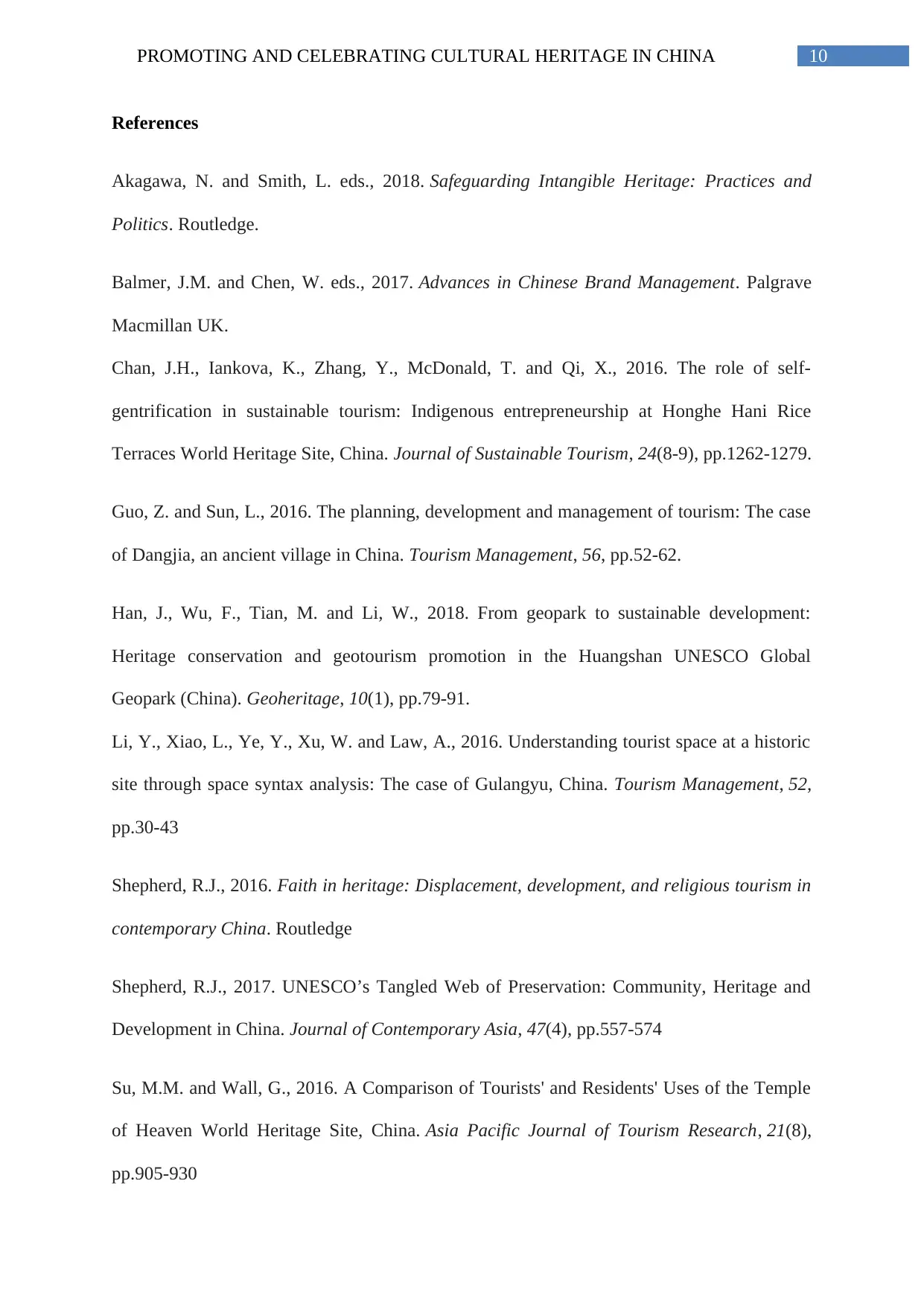
10PROMOTING AND CELEBRATING CULTURAL HERITAGE IN CHINA
References
Akagawa, N. and Smith, L. eds., 2018. Safeguarding Intangible Heritage: Practices and
Politics. Routledge.
Balmer, J.M. and Chen, W. eds., 2017. Advances in Chinese Brand Management. Palgrave
Macmillan UK.
Chan, J.H., Iankova, K., Zhang, Y., McDonald, T. and Qi, X., 2016. The role of self-
gentrification in sustainable tourism: Indigenous entrepreneurship at Honghe Hani Rice
Terraces World Heritage Site, China. Journal of Sustainable Tourism, 24(8-9), pp.1262-1279.
Guo, Z. and Sun, L., 2016. The planning, development and management of tourism: The case
of Dangjia, an ancient village in China. Tourism Management, 56, pp.52-62.
Han, J., Wu, F., Tian, M. and Li, W., 2018. From geopark to sustainable development:
Heritage conservation and geotourism promotion in the Huangshan UNESCO Global
Geopark (China). Geoheritage, 10(1), pp.79-91.
Li, Y., Xiao, L., Ye, Y., Xu, W. and Law, A., 2016. Understanding tourist space at a historic
site through space syntax analysis: The case of Gulangyu, China. Tourism Management, 52,
pp.30-43
Shepherd, R.J., 2016. Faith in heritage: Displacement, development, and religious tourism in
contemporary China. Routledge
Shepherd, R.J., 2017. UNESCO’s Tangled Web of Preservation: Community, Heritage and
Development in China. Journal of Contemporary Asia, 47(4), pp.557-574
Su, M.M. and Wall, G., 2016. A Comparison of Tourists' and Residents' Uses of the Temple
of Heaven World Heritage Site, China. Asia Pacific Journal of Tourism Research, 21(8),
pp.905-930
References
Akagawa, N. and Smith, L. eds., 2018. Safeguarding Intangible Heritage: Practices and
Politics. Routledge.
Balmer, J.M. and Chen, W. eds., 2017. Advances in Chinese Brand Management. Palgrave
Macmillan UK.
Chan, J.H., Iankova, K., Zhang, Y., McDonald, T. and Qi, X., 2016. The role of self-
gentrification in sustainable tourism: Indigenous entrepreneurship at Honghe Hani Rice
Terraces World Heritage Site, China. Journal of Sustainable Tourism, 24(8-9), pp.1262-1279.
Guo, Z. and Sun, L., 2016. The planning, development and management of tourism: The case
of Dangjia, an ancient village in China. Tourism Management, 56, pp.52-62.
Han, J., Wu, F., Tian, M. and Li, W., 2018. From geopark to sustainable development:
Heritage conservation and geotourism promotion in the Huangshan UNESCO Global
Geopark (China). Geoheritage, 10(1), pp.79-91.
Li, Y., Xiao, L., Ye, Y., Xu, W. and Law, A., 2016. Understanding tourist space at a historic
site through space syntax analysis: The case of Gulangyu, China. Tourism Management, 52,
pp.30-43
Shepherd, R.J., 2016. Faith in heritage: Displacement, development, and religious tourism in
contemporary China. Routledge
Shepherd, R.J., 2017. UNESCO’s Tangled Web of Preservation: Community, Heritage and
Development in China. Journal of Contemporary Asia, 47(4), pp.557-574
Su, M.M. and Wall, G., 2016. A Comparison of Tourists' and Residents' Uses of the Temple
of Heaven World Heritage Site, China. Asia Pacific Journal of Tourism Research, 21(8),
pp.905-930
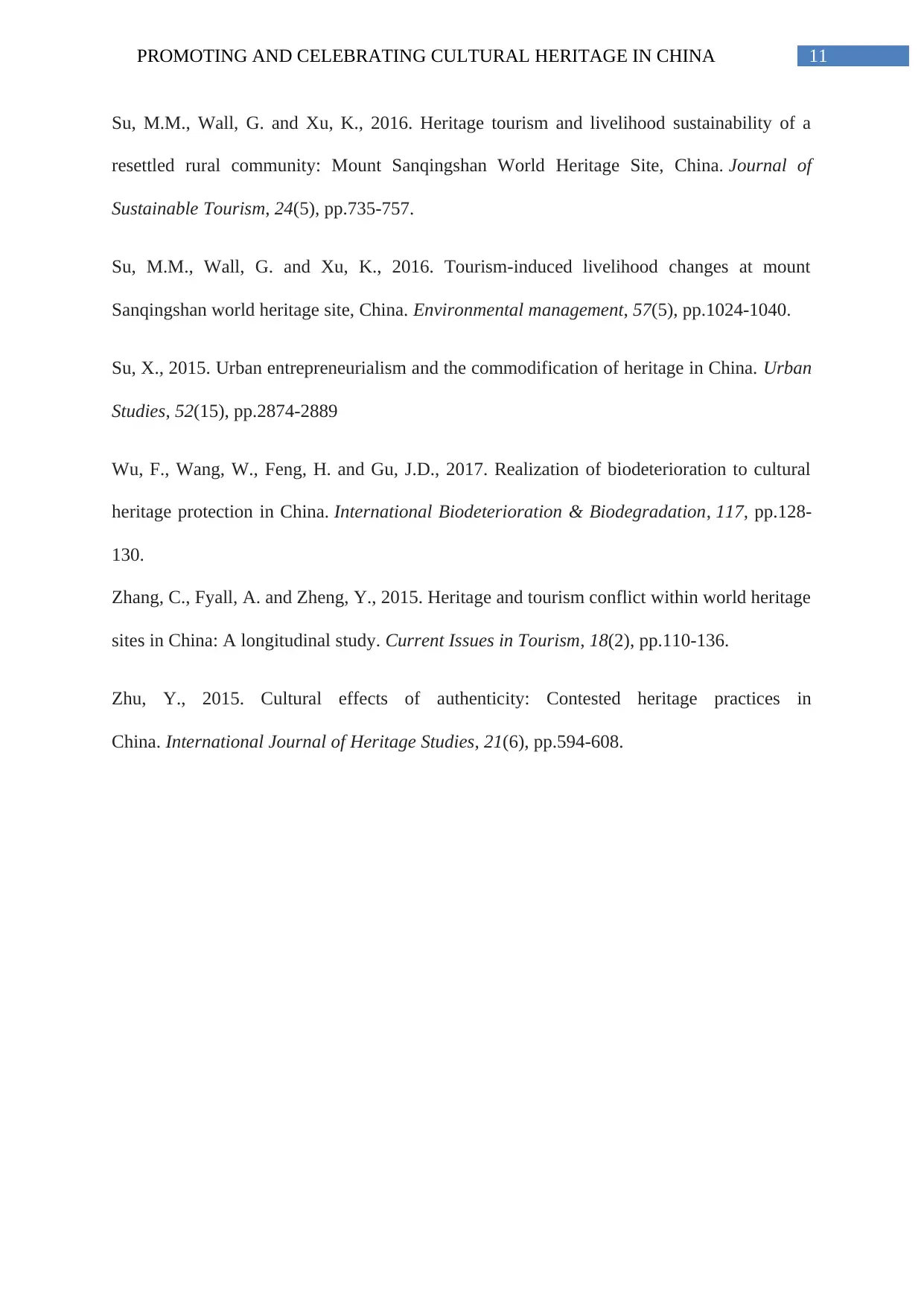
11PROMOTING AND CELEBRATING CULTURAL HERITAGE IN CHINA
Su, M.M., Wall, G. and Xu, K., 2016. Heritage tourism and livelihood sustainability of a
resettled rural community: Mount Sanqingshan World Heritage Site, China. Journal of
Sustainable Tourism, 24(5), pp.735-757.
Su, M.M., Wall, G. and Xu, K., 2016. Tourism-induced livelihood changes at mount
Sanqingshan world heritage site, China. Environmental management, 57(5), pp.1024-1040.
Su, X., 2015. Urban entrepreneurialism and the commodification of heritage in China. Urban
Studies, 52(15), pp.2874-2889
Wu, F., Wang, W., Feng, H. and Gu, J.D., 2017. Realization of biodeterioration to cultural
heritage protection in China. International Biodeterioration & Biodegradation, 117, pp.128-
130.
Zhang, C., Fyall, A. and Zheng, Y., 2015. Heritage and tourism conflict within world heritage
sites in China: A longitudinal study. Current Issues in Tourism, 18(2), pp.110-136.
Zhu, Y., 2015. Cultural effects of authenticity: Contested heritage practices in
China. International Journal of Heritage Studies, 21(6), pp.594-608.
Su, M.M., Wall, G. and Xu, K., 2016. Heritage tourism and livelihood sustainability of a
resettled rural community: Mount Sanqingshan World Heritage Site, China. Journal of
Sustainable Tourism, 24(5), pp.735-757.
Su, M.M., Wall, G. and Xu, K., 2016. Tourism-induced livelihood changes at mount
Sanqingshan world heritage site, China. Environmental management, 57(5), pp.1024-1040.
Su, X., 2015. Urban entrepreneurialism and the commodification of heritage in China. Urban
Studies, 52(15), pp.2874-2889
Wu, F., Wang, W., Feng, H. and Gu, J.D., 2017. Realization of biodeterioration to cultural
heritage protection in China. International Biodeterioration & Biodegradation, 117, pp.128-
130.
Zhang, C., Fyall, A. and Zheng, Y., 2015. Heritage and tourism conflict within world heritage
sites in China: A longitudinal study. Current Issues in Tourism, 18(2), pp.110-136.
Zhu, Y., 2015. Cultural effects of authenticity: Contested heritage practices in
China. International Journal of Heritage Studies, 21(6), pp.594-608.
1 out of 12
Your All-in-One AI-Powered Toolkit for Academic Success.
+13062052269
info@desklib.com
Available 24*7 on WhatsApp / Email
![[object Object]](/_next/static/media/star-bottom.7253800d.svg)
Unlock your academic potential
© 2024 | Zucol Services PVT LTD | All rights reserved.